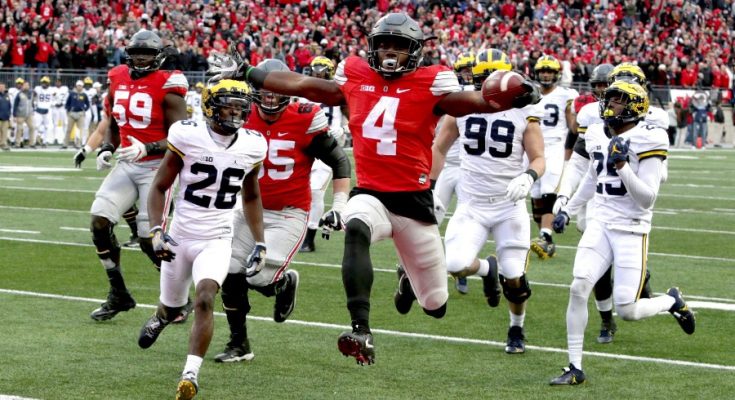RELIVE THE GLORY: Holy Buckeye, 85 Yards, Lone Star Heist, and the Brooklyn Dagger Highlight Ohio State’s Greatest Plays
The Ohio State Buckeyes are more than just a football powerhouse; they are a living, breathing monument to college football excellence. With a history that stretches back over a century and a trophy case brimming with national championships, Heisman Trophies, and Big Ten titles, Ohio State has built its legacy on countless iconic moments. But within the vast highlight reel of Buckeye greatness, a few plays stand above the rest — etched forever in the memory of fans and immortalized in the annals of college football lore.
These are the moments that turned games, defined seasons, and, in some cases, cemented legacies. Plays so dramatic, so perfectly executed, that they have become rallying cries for generations of Ohio State fans. Among them: “Holy Buckeye,” “85 Yards Through the Heart of the South,” “The Lone Star Heist,” and “The Brooklyn Dagger.” Each represents not just a flash of brilliance, but a symbol of Ohio State’s grit, talent, and sheer will to win on the biggest stages.
Let’s relive the glory.
There are few calls in college football history as instantly recognizable to Buckeye Nation as Brent Musburger’s exclamation: “Holy Buckeye!” The phrase became an instant classic, encapsulating one of the most nerve-wracking and electrifying moments in Ohio State history.
In the heart of the 2002 season, the Buckeyes were undefeated but had looked vulnerable. Traveling to West Lafayette to face Purdue, a team that always seemed to give Ohio State headaches, the Buckeyes were trailing 6-3 with just over a minute left in the fourth quarter. Faced with 4th-and-1 on Purdue’s 37-yard line, many assumed Jim Tressel would opt for a conservative play. After all, Tressel was known for his trust in defense and special teams. But instead, he called a play-action pass.
Quarterback Craig Krenzel dropped back and found wide receiver Michael Jenkins streaking down the sideline. Jenkins caught the pass in stride and raced into the end zone, silencing the Purdue crowd and igniting Buckeye Nation. The 37-yard touchdown not only won the game but preserved the team’s undefeated season. The Buckeyes would go on to win the national title that year, but without “Holy Buckeye,” the dream might have died in West Lafayette.
More than just a great play, “Holy Buckeye” represented a philosophical shift — a moment where risk met reward, and history was changed forever.
Urban Meyer’s 2014 Buckeyes were a team forged in adversity. After losing starting quarterback Braxton Miller in preseason and backup J.T. Barrett in the final regular-season game, third-stringer Cardale Jones stepped in for the Big Ten Championship — and dominated. But no one knew if the magic could continue in the inaugural College Football Playoff against Alabama in the Sugar Bowl.
Trailing 21-6 early in the second quarter, Ohio State clawed back to take a 27-21 lead. With just under nine minutes left and needing to ice the game, Ezekiel Elliott delivered one of the most legendary runs in Ohio State history. On 2nd-and-7 from their own 15-yard line, Elliott took the handoff and burst through a gaping hole on the left side. What followed was a breathtaking 85-yard sprint to the end zone, weaving through one of the most vaunted defenses in college football.
As he crossed the goal line, Elliott shattered the Crimson Tide’s hopes and launched Ohio State into the national title game. The run was more than a touchdown; it was a statement. Ohio State didn’t just belong in the playoff — they could beat the SEC’s best and do it with flair and power. “85 Yards Through the Heart of the South” became an instant classic, both for its significance and its stunning execution.
That single run turned Ezekiel Elliott into a household name and cemented his place in Buckeye lore. More importantly, it marked Ohio State’s reemergence as a national force in the post-Tressel era.
Just days after toppling Alabama, Ohio State faced the Oregon Ducks for the first-ever College Football Playoff National Championship. With momentum on their side, the Buckeyes leaned heavily on their powerful run game and dominant defense. Yet it was a single play in the third quarter — a heist, if you will — that turned the tide and all but sealed the fate of the Ducks.
Oregon trailed 21-20 and had regained a bit of momentum. Cardale Jones and the Ohio State offense were moving the ball but facing a critical third down. Then disaster struck — Jones was hit, and the ball popped out. Oregon looked poised to recover and potentially take the lead. But in the chaos, Ohio State wide receiver Corey Smith fought for the ball and somehow managed to recover it in a pile of defenders.
It wasn’t a touchdown. It wasn’t a highlight that played endlessly on SportsCenter. But it was the kind of play championship teams make — gritty, determined, and absolutely vital. The Buckeyes retained possession, scored on the drive, and never looked back.
This wasn’t a heist of glitz and glamour. It was a heist of momentum, of control, of the narrative. It symbolized Ohio State’s refusal to give in, even in moments of chaos. In the heart of Texas — deep in “Lone Star” territory — Ohio State had stolen the championship right out from under the Ducks.
Few rivalries in sports match the ferocity and history of “The Game” — Ohio State vs. Michigan. In 2016, the stakes were as high as ever. Both teams entered the game ranked in the top three, with playoff hopes on the line. The game delivered everything fans hoped for — drama, tension, and controversy.
In double overtime, Ohio State faced 4th-and-1. J.T. Barrett barely converted on a quarterback keeper — a play that still sparks debate among Wolverines fans. One play later, the dagger was delivered. Curtis Samuel, the electric all-purpose back from Brooklyn, took a handoff around the left side, found a crease, and raced untouched into the end zone.
Pandemonium. Ohio Stadium erupted. The Scarlet and Gray rushed the field. Samuel’s touchdown wasn’t just the game-winner; it was the exclamation point on one of the most emotionally charged contests in the rivalry’s storied history.
“The Brooklyn Dagger,” as it became known, was about more than a win over Michigan. It was about resilience. The Buckeyes had trailed 17-7 in the second half and looked out of sync. But behind Barrett’s leadership and Samuel’s brilliance, they clawed back. The win propelled them to the College Football Playoff, but even if it hadn’t, the moment stood alone — another defining chapter in a rivalry built on unforgettable moments.
While each of these plays stands out on its own, they share something greater — a reflection of what Ohio State football represents. They’re not just touchdowns or first downs or dramatic finishes. They’re moments of belief, of execution under pressure, of players rising to meet the moment when everything is on the line.
They span different eras and styles: Tresselball conservatism, Urban Meyer’s up-tempo spread, Ryan Day’s modern versatility. Yet the heartbeat remains the same — toughness, preparation, and a relentless pursuit of excellence.
From Craig Krenzel’s poise in West Lafayette to Zeke’s blazing speed in New Orleans; from a fumble recovery in the depths of a pile to a slicing run that silenced the Maize and Blue, these plays remind fans why they cheer, why they believe, and why Ohio State remains at the pinnacle of college football.
The greatness of a program is often measured in wins, trophies, and banners. But ask any Buckeye fan, and they’ll tell you it’s also measured in moments — those split seconds where time stands still, where hearts race, and where legends are born.
These aren’t just plays. They’re the spirit of the Buckeyes. And they’ll live forever.



